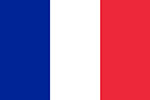Paul Signac – 1863-1935
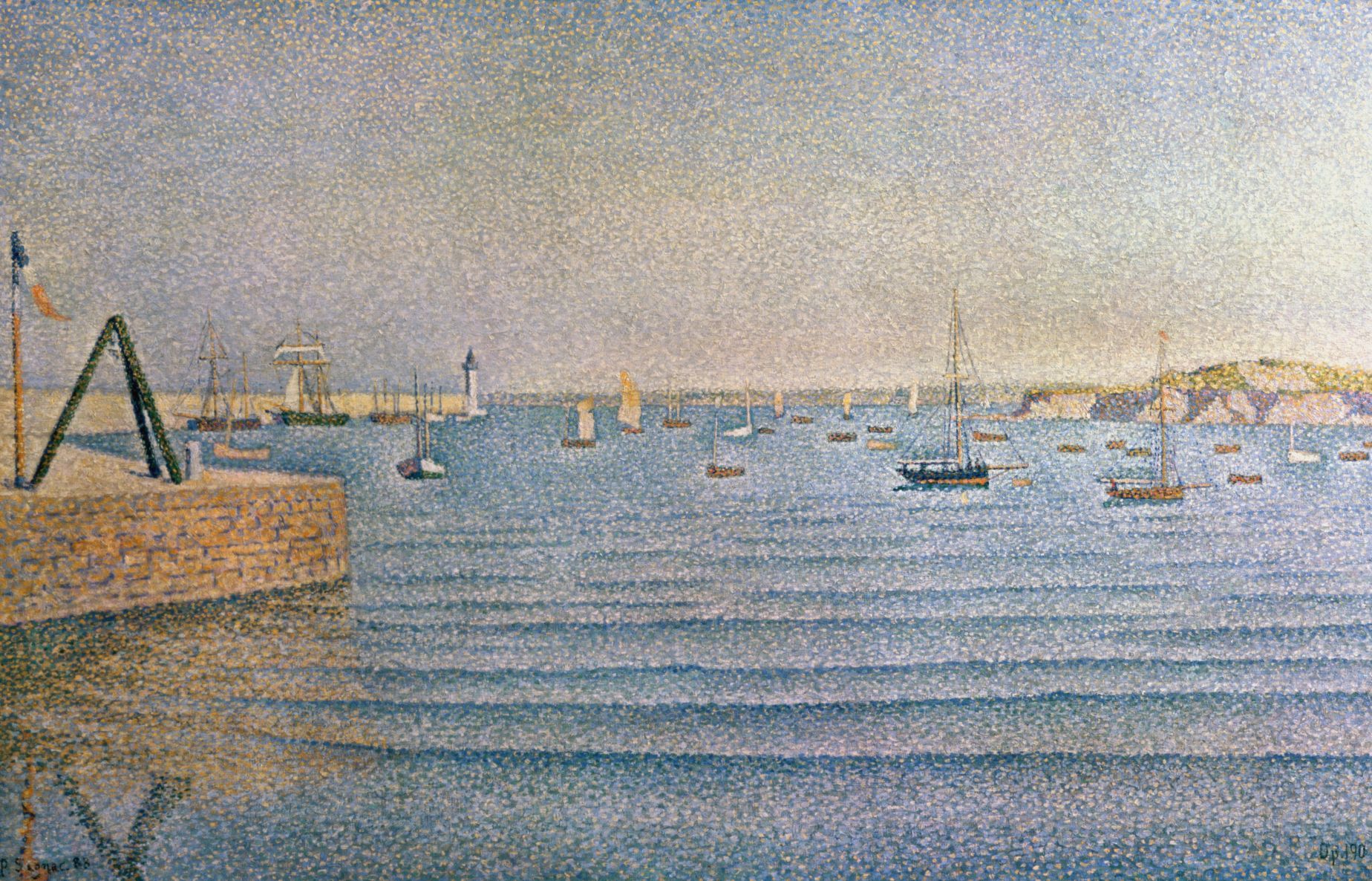
Le port de Portrieux – Paul Signac – 1888 – © Bridgeman images.
Paul Signac was born in Paris into a bourgeois family. His parents intended him to become an architect, but he was drawn to painting from an early age.
At the age of 16, he was moved by the paintings of Manet, Caillebotte, Pissarro and Degas, seen at the fourth Impressionist Salon. He admired the work of Monet, whom he would later ask for advice.
Signac decided to leave high school in 1880 to take up painting, working in Emile Blin’s studio in Montmartre. At this time, he asserted his anti-conformist ideas, manifested a constant need to escape and joined a group close to the anarchists, “les harengs saurs épileptiques baudelairiens et anti-philistins” – “Baudelairean and anti-philistine epilectoc pickled herrings” (in the anti-bourgeois sense).
In 1892, Paul Signac married Berthe Robles, a distant cousin of Pissarro, he had met at the Chat Noir. They came to Portrieux together.
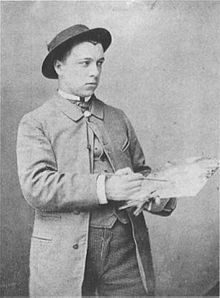
Signac jeune en 1883
Despite his close ties with Berthe, Signac met a young artist, Jeanne, and had a daughter, Ginette, with her in 1913. From then on, he lived in Antibes with his new partner. Ginette married the son of Marcel Cachin, a native of Paimpol. Their daughter Françoise Cachin, an art historian, is the author of “Signac catalog raisonné de l’œuvre peint”.
Paul Signac was appointed painter to the French Navy in 1915. From 1929, he embarked on a series of watercolors of French ports, a project that was close to his heart. From then until 1931, his travels led to a series of watercolors that crowned the talent of an artist who loved the world of the sea.
He died in Paris in 1935.
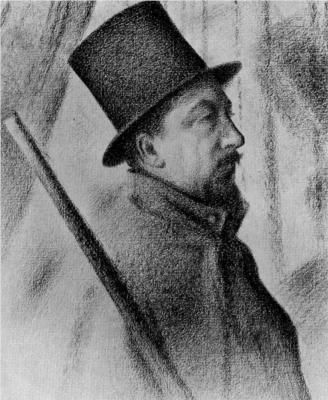
Portrait de Paul Signac – Georges Seurat
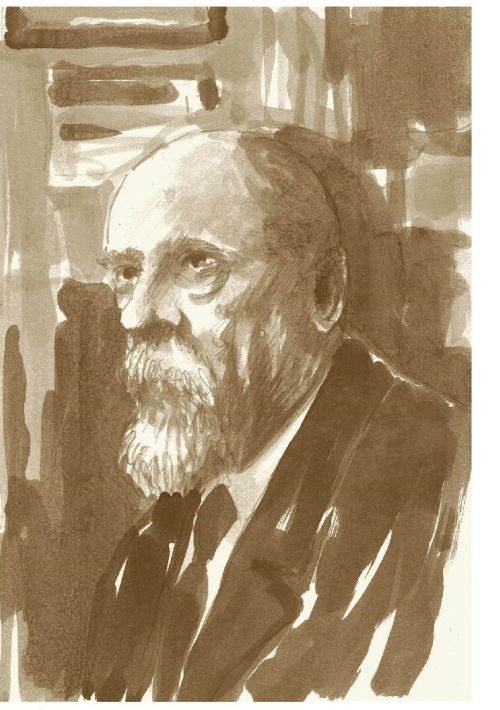
Portrait de Paul Signac – Erwan Le Saëc
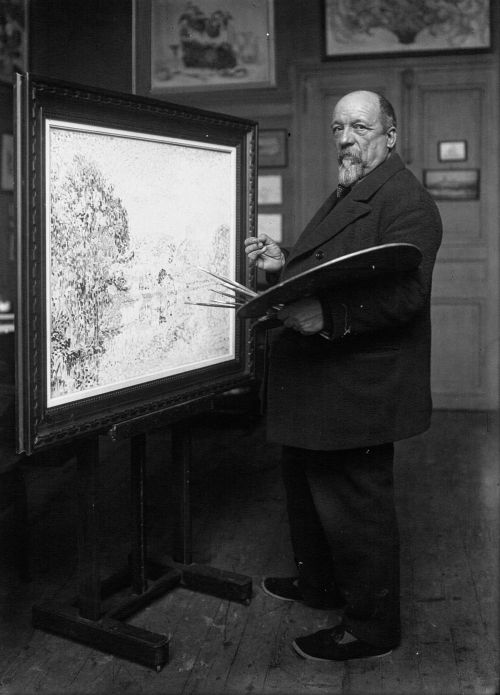
Photo de Signac en 1923
Signac, painter and sailor
Signac had two passions: painting and boating. He was a tireless sailor, a lover of freedom, a good navigator and a keen regatta competitor.
Wearing a turtleneck sweater and cap, he sailed along the Mediterranean and Breton coasts. A connoisseur of the world of the sea, he surveys the quays, observes the boats and the careening areas in the ports. In Saint Malo, he was fascinated by the large workboats that sailed to the banks of Newfoundland.
He went on to own 32 boats, from river barques to yachts over ten meters long, including a cutter commissioned from a shipyard in Roscoff, which he named Olympia after Manet’s scandalous painting of the same name. Living aboard, he won numerous regattas between Douarnenez and Concarneau.
He humorously named one of his boats the epileptic herring and another the tub, in reference to a pastel by Degas and a play on words to designate the boat that fills up when it’s becalmed.
The sea and boats play an essential role in the artist’s life. He travelled extensively by the sea, in the South of France, Holland, England, Italy and the English Channel.
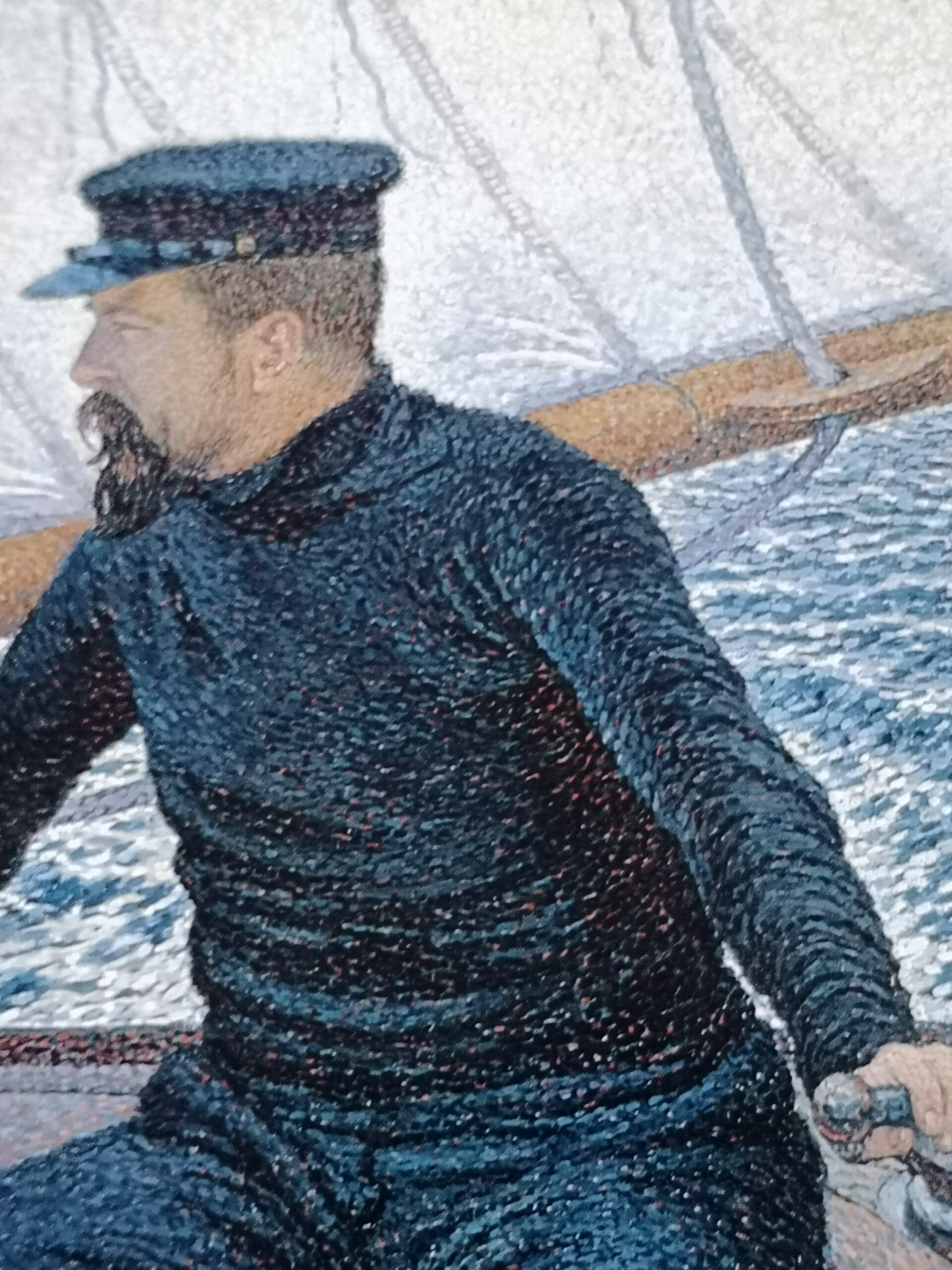
Signac sur son bateau – Theo van Rysselberghe – 1896 – Collection particulière.
Signac and Brittany
It was his friend Seurat, his love of the sea and his passion for sailing that first brought him to Saint-Briac in 1885. Always at the helm of a boat, he made stopovers in Saint-Malo, Saint Cast and all the surrounding ports.
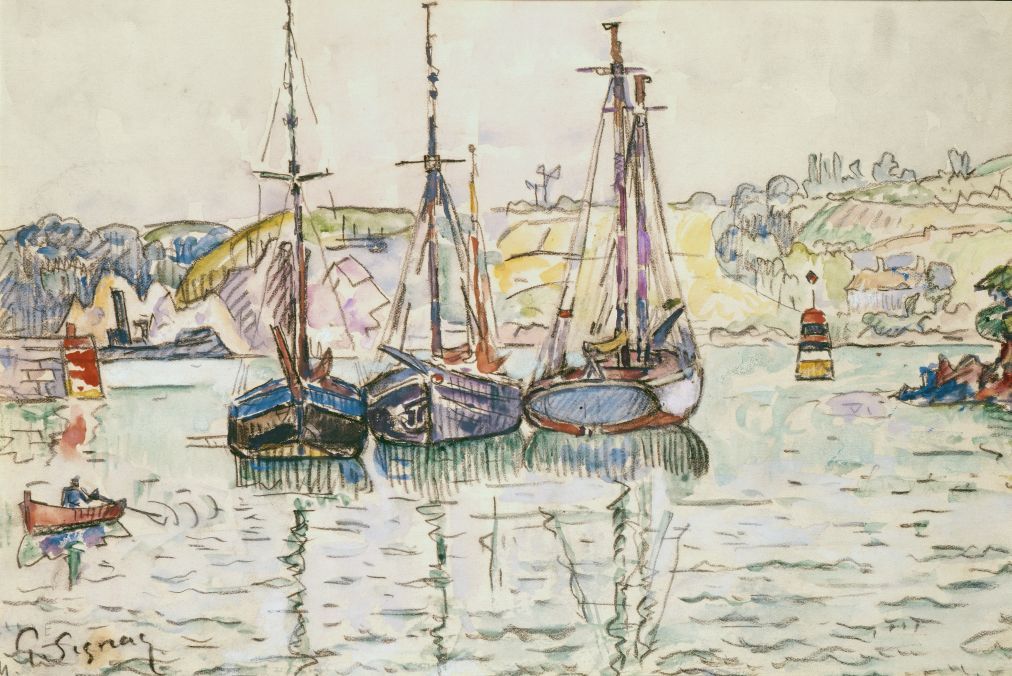
Lézardrieux les bateaux – Paul Signac – © Bridgeman Images

Le pont de Lézardrieux – Paul Signac -© Bridgeman Images
Signac also made regular stopovers in Lézardrieux. He wintered his boat in the Trieux, at the lighthouse and beacon park, and rented a house in Kermaquer en Lézardieux from 1924 to 1930, near his relative Marcel Cachin. The Bréhat archipelago holds no secrets for him. He discovered the drawings of Louis Marie Faudacq and collected his notebooks, amazed by the virtuosity of his illustrations. He became close to Charles Lapicque, who sailed around the Arcouest, and knew Henri Rivière well, with whom he had shared a studio in 1882.
It was because he admired Boudin’s series of maritime scenes painted at Portrieux that Paul Signac came to anchor in the port in 1888. It was by sea that he discovered Portrieux, in the company of his wife Berthe and a couple of friends. He wrote “Portrieux. Jetties, sloops, bitterns, yawls, semaphore, Icelandic schooner, bad rocks, lighthouse and beacons: summary of a small Breton port.” (Denise Delouche)
While intriguing the locals with his very personal translation of the landscape, he produced a dozen paintings during his stay. Symbolist poet Jean Ajalbert, who accompanied him, wrote: “While Paul Signac on the jetty painted a navy where the natives hardly recognized their masts and sails […], we crossed from Portrieux to Jersey”. (Quoted in the Metropolitan Museum of Art NY exhibition catalog)
In fact, the painter spontaneously transcribes his emotions onto canvas, using small, juxtaposed strokes of pure color to reveal the shimmer of light and the shimmer of water. Signac would say that he “wanted to push every corner of the canvas to the absolute extreme in terms of color”. And it’s all the shimmer of light and the shimmer on the water that appear. “At Portrieux, Signac painted seascapes with a balance and gentleness that he may never have matched. Signac had been particularly sensitive to the austere poetry of these landscapes made of the interplay of water, light and rock. It was in Portrieux that he was most attached to the decorative and synthetic values of lines, and to the effects of contrast”(Françoise Cachin).

Signac au travail – Erwan Le Saëc
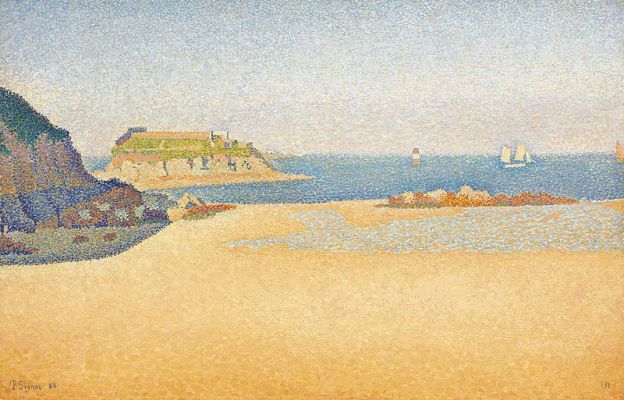
La Comtesse opus 191 – Paul Signac – © Bridgeman images
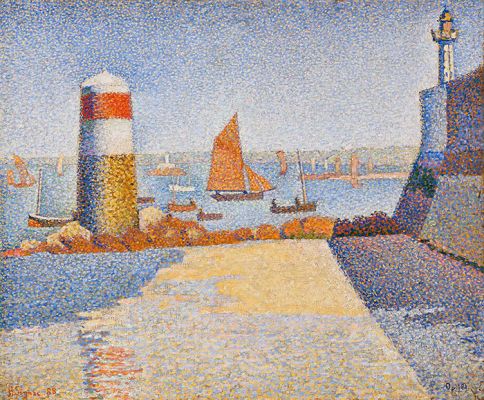
Le Gourvelot – Paul Signac – Musée d’Art d’Hiroshima
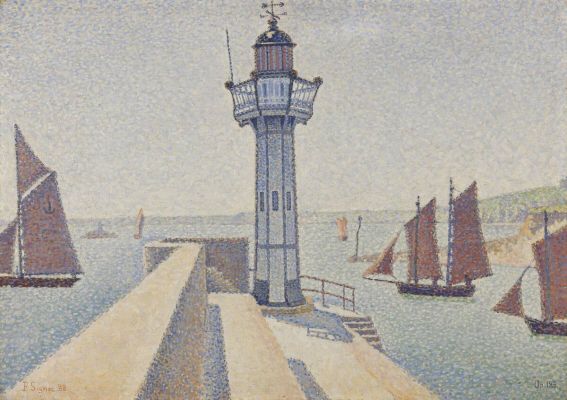
Le phare opus 183 – Paul Signac – Musée Kröller Müller
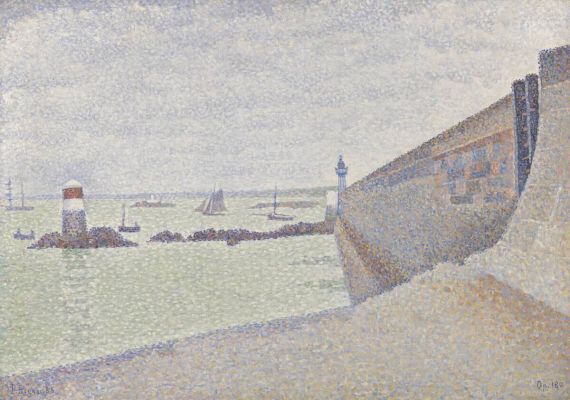
La jetée par temps gris – Paul Signac – Musée Kröller Müller

Les cabines de bain plage de la comtesse – opus 185 – Paul Signac – Musée d’art Nelson-Atkin
Signac the collector
As a passionate collector, Signac bought or exchanged canvases, drawings, sketches and prints with a discerning eye, which he also studied to deepen his knowledge. He was aware that he lived among brilliant painters, often his friends, and the works he acquired reflected his view of his artistic choices. His collection of some 400 works has been on show at the Musée d’Orsay from October 2021 to February 2023.
This tirelessly inquisitive artist showed a deep interest in his peers, devoting himself to them with professional admiration.
Signac, color through to pointillism
His meeting with Georges Seurat (1859-1891) and Camille Pissaro (1859-1891) at the 1884 Salon des Indépendants was decisive for the direction he would take in his work. This non-juried, non-awarded salon welcomed artists who had been rejected by the official salon committee as being too strict in terms of Impressionist orthodoxy, and who wished to exhibit their work freely, without straitjackets.
Seurat, initiator of the chromo-luminarism technique, and Signac founded the “Scientific Impressionists” group, and in their painting projected the foundations of a new movement, Pointillism.
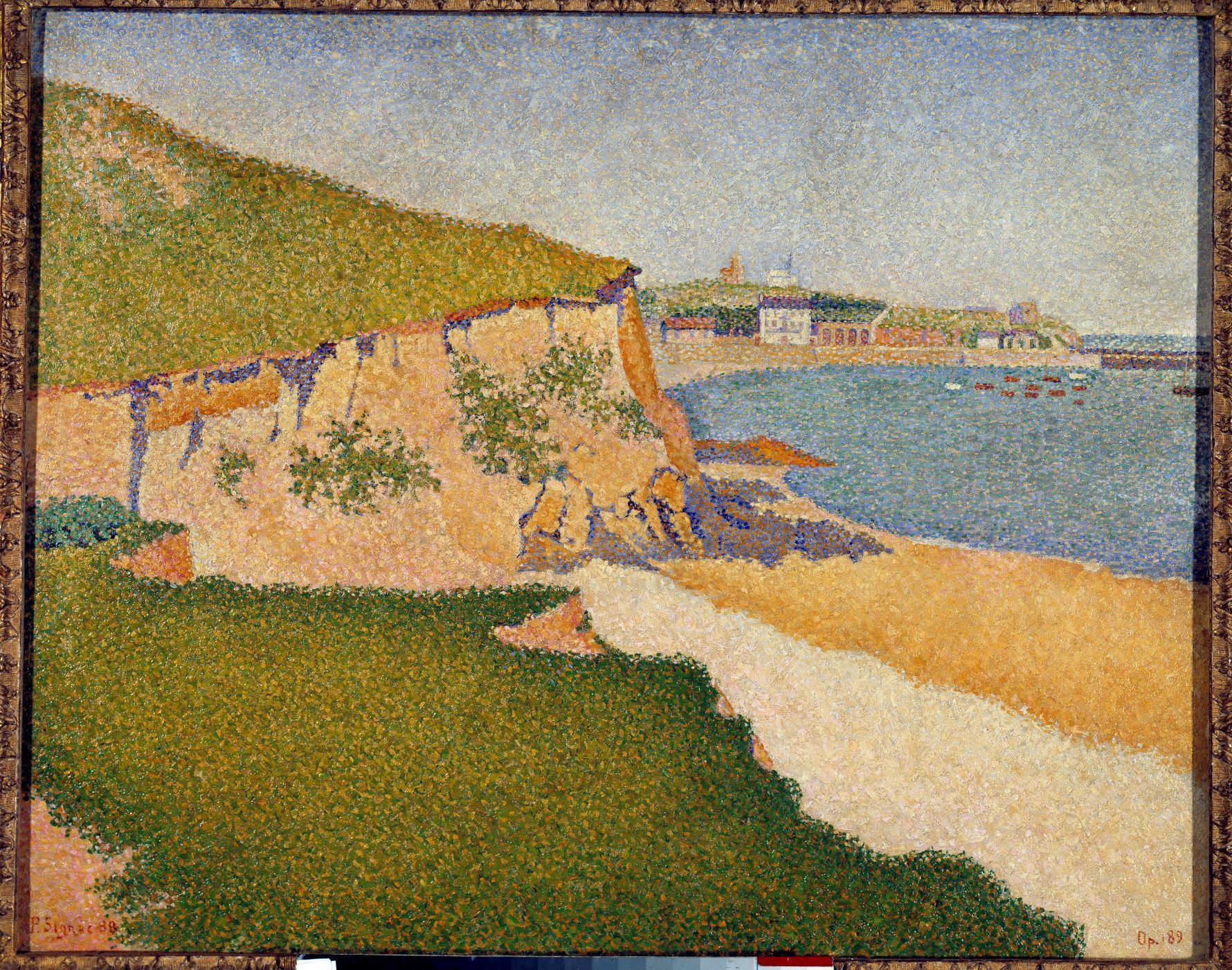
Le Tertre Denis – opus 189 – Paul Signac-© Bridgeman Images
Paul Signac was fascinated by the science of color, which he divided according to precise rules studied by chemists. Pure primary colors (yellow, red, blue) and secondary colors (green, orange, violet) are not mixed on the palette. It’s up to the eye to make a harmonious association by fusing them, thus rendering the vibrations of light from the sky and water.
After four years without a salon, an eighth Impressionist exhibition was held in 1886. Entries were submitted to Berthe Morisot, because of her financial involvement in the project. With great open-mindedness, she invited Signac and Seurat to hang their works, which was not without conflict with some of the participants. “There are some rebels among the independents who deserve to be watched,” says a critic in Le Moniteur des arts.
Recognition would come with the evolution of mentalities.
In 1891, the premature death of his great friend Georges Seurat hit him hard. Signac moved to the south of France.
Always in search of innovation, in 1899 he published a book on the theory of Divisionism, from Eugène Delacroix to Neo-Impressionism, a veritable plea in favor of this new way of fragmenting paint strokes, like dots.
In 1909, he was appointed president of the Société des Artistes Indépendants, founded by free-spirited painters such as Sisley, Monet, Renoir and Bazille.
Interested in all the modernist currents in painting, he devoted a great deal of energy to his position until 1934, welcoming painters struggling to free themselves from the yoke of criticism.
Through his creative research, Paul Signac was one of the founders of modernism in painting, paving the way for Fauves like Matisse and Derain and abstractionists like Klee, Mondrian and Kandinsky.
It is interesting to note Signac’s parallelism between his works and music, since from 1882 to 1894, he catalogued them with opus numbers, a practice he reserved for his most accomplished works.
Some fifty museums worldwide own works by Paul Signac.
